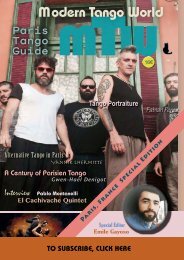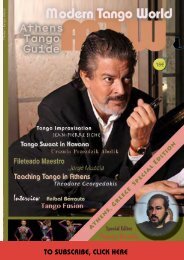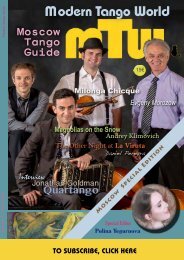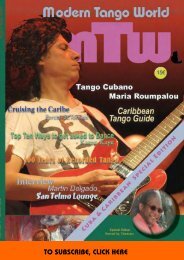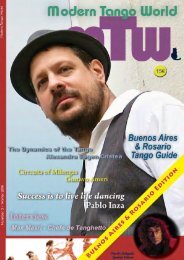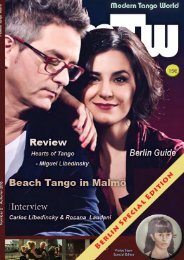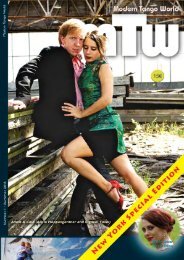Modern Tango World #5 (Mexico)
Mexico Special Features Milongas in the Park Roberto González 3 Snapshot of the Mexican Music Scene Miguel Garcia 6 A New Generation Mauricio Salvador 12 Guide to Tango in Mexico 16 Visual Tango Poems Murat Erdemsel 22 Interview with Plaza Francia Marco Buso 26 Tango Therapy Around the World 30 Movie Review: Tango Pasion Alexandru Eugen Cristea 33 New Tango Music Arndt Büssing 34 Horacio Salgan: Tango Giant 38 DJ/VJ-ing - A VJ Manifesto Zarah Cabanas 40 Tango Moves: caminando Raymond Lauzzana 44 Letters to the Editor 47
Mexico Special Features
Milongas in the Park Roberto González 3
Snapshot of the Mexican Music Scene Miguel Garcia 6
A New Generation Mauricio Salvador 12
Guide to Tango in Mexico 16
Visual Tango Poems Murat Erdemsel 22
Interview with Plaza Francia Marco Buso 26
Tango Therapy Around the World 30
Movie Review: Tango Pasion Alexandru Eugen Cristea 33
New Tango Music Arndt Büssing 34
Horacio Salgan: Tango Giant 38
DJ/VJ-ing - A VJ Manifesto Zarah Cabanas 40
Tango Moves: caminando Raymond Lauzzana 44
Letters to the Editor 47
Create successful ePaper yourself
Turn your PDF publications into a flip-book with our unique Google optimized e-Paper software.
Snapshot of the <strong>Mexico</strong> <strong>Tango</strong> Music Scene<br />
Miguel Garcia<br />
Orquesta Mexicana <strong>Tango</strong><br />
The tango scene in <strong>Mexico</strong> is mostly Gardelian. Since the early decades of the twentieth century,<br />
the Gardel phenomenon found a home in <strong>Mexico</strong>, as it did in almost all Spanish-speaking<br />
countries. The importance of beginning is not lost among regular listeners of the River Plate<br />
music in <strong>Mexico</strong>, which has resulted in a preference sung tango compared to other forms.<br />
Later, the immigration of Argentines and their<br />
distinguished music and films enriched the range<br />
of styles and preferences of tango reaching the<br />
Mexican audience. The taste for instrumental<br />
tango is fairly recent, by comparison. The arrival<br />
in <strong>Mexico</strong> of a spectrum of tango music, from<br />
the Canaro brothers, through Mariano Mores<br />
to Piazzolla and Pugliese, had much to do with<br />
the predilection of the public taste for tango.<br />
These were exceptional moments in our country’s<br />
history.<br />
There is a natural mutual admiration between<br />
tango musicians and Mexican musicians. As an<br />
example, see the album <strong>Tango</strong> in <strong>Mexico</strong>, with<br />
invaluable work of Gastón Martinez Matiella.<br />
Some musicians left, others came, some stayed<br />
and remains here today. There are many Mexican<br />
artists engaged in the culture of tango, There<br />
are also many Rio Plate artists who have stopped<br />
in <strong>Mexico</strong> enrichinh the urban music in our land.<br />
This has has preserve tngo’s traditions while remains<br />
true to the corrent times.<br />
But, the subject of this article<br />
is not the history of<br />
tango in <strong>Mexico</strong>. I leave<br />
that subject to music historians.<br />
These lines of text<br />
are intended to review of<br />
the tango ensembles and<br />
assemblies which constitute<br />
the current scene<br />
in <strong>Mexico</strong> — a kind of<br />
snapshot of tango as it<br />
is currently in our country.<br />
I won’t deal lyricists<br />
and composers, as the list<br />
would grow beyond what<br />
these pages could contain.<br />
Instead, I will focus<br />
only on those tango artists<br />
who frequently participate<br />
in shows, milongas,<br />
concerts or festivals.<br />
— 6 —<br />
Gitanguero




